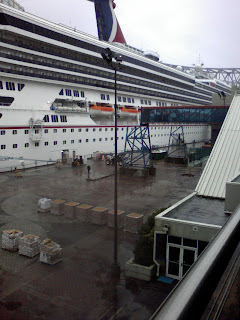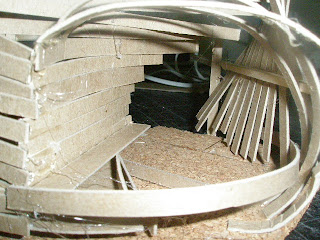Monday, March 29, 2010
Friday, March 12, 2010
Monday, March 8, 2010
Project 02b: A Quarantine Cell
The second project this semester is to design a unit for quarantine of an individual. The design should be 'off the grid' and accommodate one person for forty days. I came across a design on the internet for the Sleep Box - individual pods for travelers at airports or train stations,made to accommodate someone resting in between trips.
http://www.dezeen.com/2009/11/10/sleepbox-by-arch-group/
The Sleep Box is roughly 2 by 1.5 meters, and is sufficient for a person to spend maybe an hour inside. It makes good use of valuable space, but a person spends only a short amount of time inside. The challenge of this quarantine project is figuring out a way to hold a person inside a small, monitored space for forty days, and make it bearable.
I started by building five models to work through organizing flow of movement and circulation through the space. I documented movement, water, air flow, and spaces.





Our design is for those traveling to New Orleans and immediately being quarantined in protection against an outbreak in the city, and our site is the Port of New Orleans.






The quarantined individual would enter the unit directly from a cargo entrance from the boat. Since there is wind in the north-south direction and little wind from east-west, I'm planning to harness wind for the building's energy source. In the protection device project, my glove was composed of materials wrapping and forming around the hand, creating a grain. I want to create that same feel with the living space. The curved, winding surfaces wrap around the space and create a feeling of movement in the room. The 'grain' of the form of the quarantine unit would be more closed on the north and south sides, but let in air from the east and west sides. I'm planning to design the pattern to relate to the movement, energy generation, and protection of the space.






http://www.dezeen.com/2009/11/10/sleepbox-by-arch-group/
The Sleep Box is roughly 2 by 1.5 meters, and is sufficient for a person to spend maybe an hour inside. It makes good use of valuable space, but a person spends only a short amount of time inside. The challenge of this quarantine project is figuring out a way to hold a person inside a small, monitored space for forty days, and make it bearable.
I started by building five models to work through organizing flow of movement and circulation through the space. I documented movement, water, air flow, and spaces.





Our design is for those traveling to New Orleans and immediately being quarantined in protection against an outbreak in the city, and our site is the Port of New Orleans.






The quarantined individual would enter the unit directly from a cargo entrance from the boat. Since there is wind in the north-south direction and little wind from east-west, I'm planning to harness wind for the building's energy source. In the protection device project, my glove was composed of materials wrapping and forming around the hand, creating a grain. I want to create that same feel with the living space. The curved, winding surfaces wrap around the space and create a feeling of movement in the room. The 'grain' of the form of the quarantine unit would be more closed on the north and south sides, but let in air from the east and west sides. I'm planning to design the pattern to relate to the movement, energy generation, and protection of the space.






Sunday, February 21, 2010
Friday, February 12, 2010
Wednesday, February 3, 2010
Site Model and Device Materiality

While trying to figure out the best method of modeling my hand, I came across a kit at Hobby Lobby for making plaster models of babies' hands and feet. Since I have relatively small hands and the package advertises picking up "every cute little wrinkle," I decided to try it out.

My first trial deemed successful - though my hand was a little too clenched and the fingers turned out brittle and cracking. My second model presented the form that I wanted, but it didn't have the texture quality of my first. I plan to scan the model into a 3D scanner because I'd like to preserve the detail of my plaster hand.

The next step was to choose a material for my protective device. I chose to use cork. According to encyclopedia.com, "cork is a specialized secondary tissue produced by the cork cambium of the plant." The material is impermeable, buoyant, fire retardant, and a natural insect repellent. There are fabric forms of cork on the market, but I priced them at about $160 a yard - so I decided to buy cork sheets at the craft store and try out making it on my own. I tried using a vegetable peeler. I tried running it through the food processor. I boiled it. I steamed it. The cork stayed brittle but would not break up. My most successful attempt was actually cutting the cork into one-sixteenth inch strips and coating them with Mod Podge.
A hunter needs a glove that is thermal and durable while staying comfortable on the hand. in the process of creating a weave pattern to construct the glove itself. It would essentially be an alternative to a leather glove, and it would wrap the hand instead of slipping over it. Hunters, while using guns, make use of the index finger and thumb. While using a knife, hunters use the palm and the bottoms of the fingers. I hope to create an integrated set of hand guards that morph to fit the needs of the hunter.
Subscribe to:
Posts (Atom)






